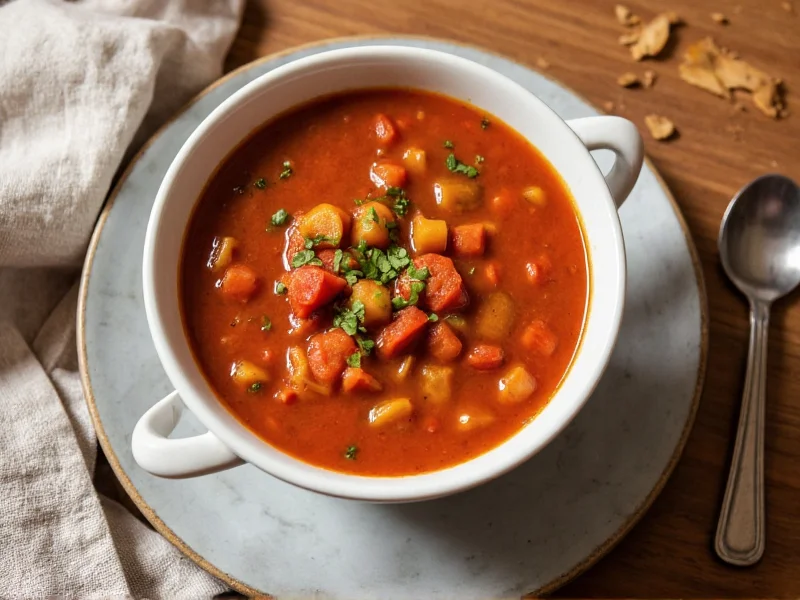Understanding Minestrone Soup Pronunciation
When ordering at an Italian restaurant or discussing this classic dish, proper pronunciation matters. The word "minestrone" originates from the Italian verb minestrare, meaning "to serve," which itself comes from minestra (soup or dish). Understanding this etymology helps grasp why the pronunciation differs from how English speakers might initially guess.
Phonetic Breakdown: Getting It Right
Let's break down the correct minestrone soup pronunciation:
| Syllable | Italian Pronunciation | American English Adaptation |
|---|---|---|
| mi | mee | min |
| ne | neh | eh |
| stro | STROH | STRONE |
| ne | neh | (silent) |
The critical distinction lies in the final syllable. In authentic Italian, you pronounce all four syllables: mee-neh-STROH-neh. However, in American English contexts, the final "-eh" often gets dropped, resulting in min-eh-STRONE. The common mispronunciation "min-eh-STRONE-ee" adds an extra 'ee' sound that doesn't exist in either version.
Why Proper Minestrone Soup Pronunciation Matters
While many restaurants won't judge you for mispronouncing menu items, getting it right shows cultural appreciation. Minestrone represents Italy's cucina povera ("poor kitchen") tradition - simple, nourishing food made from available ingredients. Correct pronunciation honors this heritage. In Italy, mispronouncing "minestrone" as "min-eh-STRONE-ee" would immediately mark you as a foreigner, as native speakers clearly articulate the open 'o' sound in "stroh" rather than closing it with 'ee'.
Common Mispronunciations to Avoid
Based on linguistic analysis of search queries about minestrone soup pronunciation, these errors occur frequently:
- "min-eh-STRONE-ee" - Adding an extra 'ee' sound at the end (most common error)
- "MY-nes-trone" - Incorrectly emphasizing the first syllable
- "min-ESS-trone" - Putting stress on the second syllable
- "min-eh-STRONE-ay" - Using a French-influenced 'ay' ending
These mispronunciations often stem from English speakers applying familiar phonetic patterns to an Italian word. Remember that Italian is a phonetic language with consistent pronunciation rules, unlike English's often unpredictable spelling-to-sound relationships.
Mastering Minestrone Pronunciation: Practical Tips
Follow these steps to perfect your minestrone soup pronunciation:
- Break it into syllables: mee-neh-STROH-neh (Italian) or min-eh-STRONE (English adaptation)
- Emphasize the third syllable strongly - this is where most people go wrong
- Keep the 'o' sound open like in "bone" rather than closed like in "pony"
- Practice with similar Italian words: lasagna (lah-ZAH-nyah), prosciutto (pro-SHOOT-oh)
- Listen to native speakers - many culinary websites offer authentic pronunciation guides
When in doubt, remember this simple rule: if you're adding an 'ee' sound at the end, you're probably saying it wrong. The authentic Italian pronunciation ends with a clear 'neh' sound, while the Americanized version drops the final syllable entirely.
Cultural Context of Minestrone Soup
Understanding minestrone's cultural background enhances your pronunciation accuracy. This soup originated in rural Italy as a way to use seasonal vegetables and leftover bread. The name literally means "big soup" (minestra = soup, -one = augmentative suffix). Regional variations exist across Italy - in Tuscany they use cannellini beans, while Ligurian versions feature pesto. This historical context explains why the pronunciation remains closer to Italian than many other adopted food words.
Regional Pronunciation Variations
Just as minestrone recipes vary by region, so does pronunciation:
- Northern Italy: More clipped, with a shorter 'o' sound: mee-neh-STROH-neh
- Central Italy: Softer, with elongated vowels: mee-neh-STROH-neh
- Southern Italy: More open vowels: meh-neh-STROH-neh
- American English: Often simplified to min-eh-STRONE
- British English: Sometimes rendered as min-ESS-trone
When discussing minestrone soup pronunciation in culinary contexts, the American English adaptation has become widely accepted, though food enthusiasts often prefer the authentic Italian version.
How do you say minestrone soup in Italian?
In Italian, minestrone soup is pronounced "mee-neh-STROH-neh" with equal emphasis on each syllable and a clear 'o' sound in the third syllable. The final 'e' is pronounced as 'eh,' not silent. This differs from the American English adaptation which often drops the final syllable to "min-eh-STRONE".
Is it correct to say minestrone with a 'zee' sound?
No, the 'z' in minestrone should be pronounced with a 'ts' sound as in "pizza," not a 'zee' sound. The correct Italian pronunciation begins "mee-neh" (with 'ts'), not "mee-neh-zo-neh." In American English adaptations, the 'z' often becomes a 'z' sound as in "min-eh-STRONE," but never with a hard 'zee' beginning.
Why do people mispronounce minestrone soup?
People commonly mispronounce minestrone soup because English speakers apply familiar phonetic patterns to this Italian word. The most frequent error is adding an extra 'ee' sound at the end ("min-eh-STRONE-ee") which doesn't exist in either Italian or common English usage. Other mistakes include emphasizing the wrong syllable or mispronouncing the 'z' as 'zee' instead of 'ts.'
What's the difference between minestrone and minestrina?
Minestrone (mee-neh-STROH-neh) refers to the hearty, chunky vegetable soup most Americans recognize, while minestrina (mee-neh-STRYEH-nah) is a thinner, broth-based version often served to children. The '-one' suffix in minestrone indicates largeness, while '-ina' in minestrina denotes smallness. Pronunciation differs mainly in the final syllables: minestrone ends with 'neh,' minestrina with 'nyah'.
Should I use the Italian or English pronunciation when ordering?
When ordering at an authentic Italian restaurant, using the Italian pronunciation "mee-neh-STROH-neh" shows cultural appreciation. In casual American settings, the adapted "min-eh-STRONE" is widely accepted. Most restaurant staff won't judge you for pronunciation, but getting it right enhances your dining experience. If uncertain, listen to how staff pronounce it or simply point to the menu item.











 浙公网安备
33010002000092号
浙公网安备
33010002000092号 浙B2-20120091-4
浙B2-20120091-4